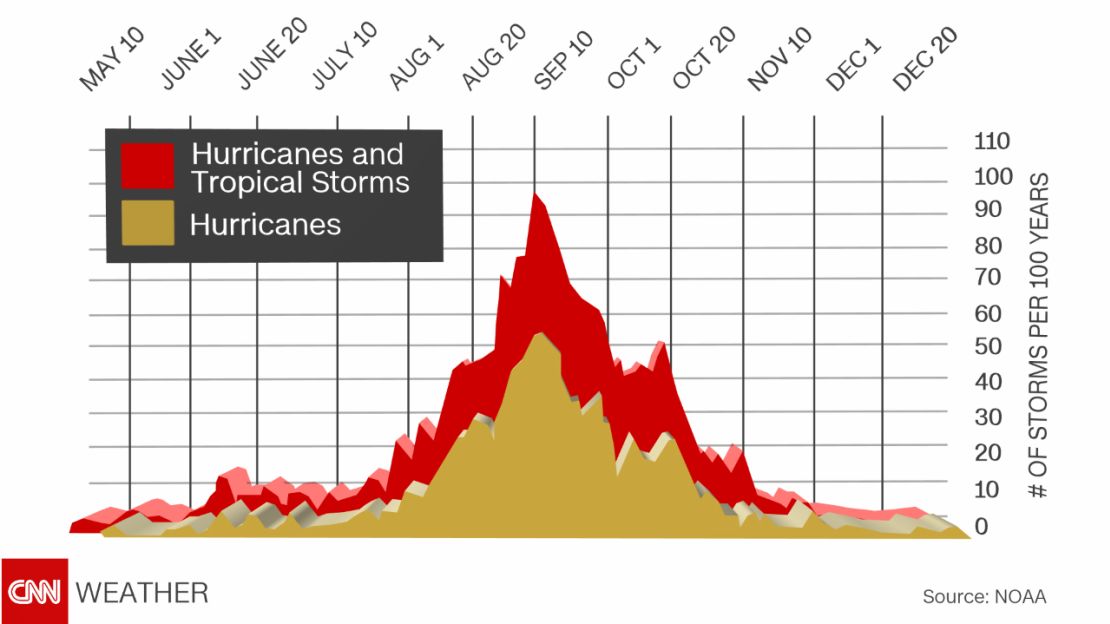The 2018 hurricane season is shaping up to be “near- or above-normal” – though not to the degree seen last year, when 17 named storms formed and three major hurricanes struck US soil – the National Oceanic and Atmospheric Administration, or NOAA, said Thursday.
Ten to 16 named storms – including five to nine hurricanes, and one to four major hurricaneswith Category 3 strength or higher – are predicted this Atlantic hurricane season, which begins June 1, the federal agency predicted.
Last year’s season ended with 10 hurricanes and six major hurricanes. The Atlantic basin annually averages 12 named storms, with six hurricanes and three major hurricanes.
NOAA added that there is a 75% chance that the 2018 season will see near or more than the average number of storms in the basin.
“The devastating hurricane season of 2017 demonstrated the necessity for prompt and accurate hurricane forecasts,” US Commerce Secretary Wilbur Ross said.
As usual, the latest forecast cannot offer the bit of information most critical to residents living in hurricane-prone areas, from the Gulf Coast of Texas to the Carolinas and, sometimes, as far north as Boston: precisely where this year’s storms might strike.
Harvey, Irma and Maria last year took aim, respectively, at the Houston area, Florida and Puerto Rico. They put a dramatic end to a 12-year period with no major hurricane landfalls in the United States and ranked among the top five costliest hurricanes in history.
El Niño pattern could make for fewer storms
The 2017 season was very active, in part, because of a weak La Niña that developed during the six-month hurricane season that ends December 1.
La Niña is a naturally occurring phenomenon characterized by cooler than normal water in the eastern Pacific equatorial region. While La Niña occurs in the Pacific Ocean, it has a widespread impact on the global climate. That includes decreased wind shear across the tropical Atlantic, which creates favorable conditions for tropical development.
But La Niña has since disappeared, making way for what are now “ENSO-neutral conditions” – meaning neither La Niña nor its opposite, El Niño, is present – according to Gerry Bell, lead hurricane season forecaster with NOAA’s Climate Prediction Center.
“The models are suggesting that El Niño could possibly develop later in the season,” Bell said Thursday.
El Niño features warmer water in the eastern Pacific equatorial region, creating greater wind shear in the Atlantic, and thus, fewer tropical storms.
If El Niño does develop by October, “it could possibly shut down or weaken the latter part of the season,” Bell said.
But that is certainly no guarantee. And if El Niño fails to make an appearance, Bell warned, “We could certainly see the seasonal activity near the higher-end of the predicted range.”
Other 2018 season forecasts
Beyond the National Oceanic and Atmospheric Administration, dubbed NOAA, most meteorologists agree that the 2018 season will be near or above average.

Colorado State University, among the most well-regarded forecasting institutions, has predicted 14 named storms, with seven hurricanes and three major hurricanes. It will update its forecast, issued last month, on May 31.
The Weather Company predicts slightly less activity than Colorado State. It forecasts a season that’s near average, with 12 named storms, including five hurricanes and two major hurricanes.
Meantime, North Carolina State University researchers expect 14 to 18 named storms, with seven to 11 hurricanes and three to five major hurricanes.




